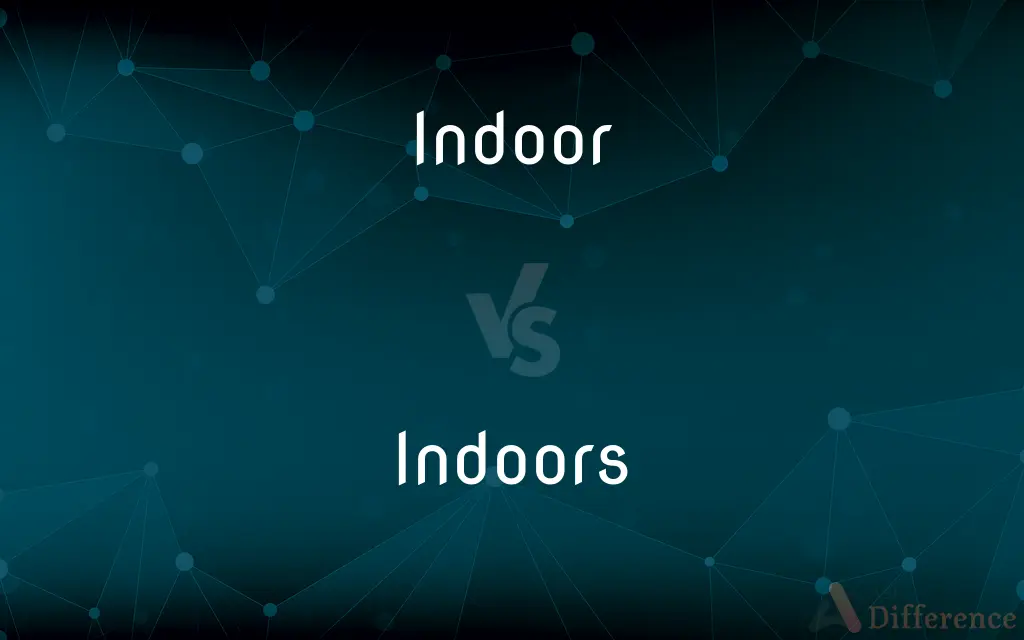Indoor vs. Indoors — What's the Difference?
Edited by Tayyaba Rehman — By Fiza Rafique — Updated on March 29, 2024
"Indoor" is an adjective describing activities or things located inside a building, while "indoors" is an adverb describing the action of being or moving inside a building.

Difference Between Indoor and Indoors
Table of Contents
ADVERTISEMENT
Key Differences
"Indoor" is used to modify nouns and describe things that are situated within or designed for use inside buildings, such as indoor plants or indoor swimming pools. This term highlights the nature or purpose of an object or activity as being intended for or occurring within an enclosed space. On the other hand, "indoors" is primarily used to indicate the location or movement of someone or something going into or being inside a building. It acts as an adverb, modifying verbs, to convey actions taking place within an indoor environment, such as staying indoors during a storm.
The use of "indoor" is to attribute characteristics or specify the setting of activities and objects, emphasizing that they belong, occur, or are used inside. For example, indoor games or indoor lighting fixtures are intended for or situated within an indoor setting. Whereas "indoors" serves to describe the action or state of being inside, often used in instructions or descriptions of activities, such as moving a party indoors due to rain.
"Indoor" can be part of compound nouns or adjectives, creating terms like "indoor sports," which refers to sports designed to be played inside buildings. "Indoors," however, is used in contexts that discuss the preference, requirement, or condition of being inside, such as choosing to dine indoors rather than outside.
While "indoor" is concerned with qualifying the nature of objects, spaces, or activities as being inside, "indoors" focuses on the placement or action of being inside. This distinction is important in understanding when to use one over the other based on whether the need is to describe a characteristic (indoor) or an action/location (indoors).
Despite these differences, both "indoor" and "indoors" share the common theme of relating to or involving spaces within buildings or structures, contrasting with outdoor or outdoors activities and locations that are situated or taking place outside.
ADVERTISEMENT
Comparison Chart
Part of Speech
Adjective
Adverb
Usage
Describes things or activities within buildings.
Indicates being or moving inside a building.
Examples
Indoor pool, indoor garden.
Going indoors, to stay indoors.
Compound Forms
Used in compound nouns/adjectives.
Used alone to modify verbs.
Context
Specifies setting or nature of activities/objects.
Describes actions or states of being inside.
Compare with Definitions
Indoor
Activities performed inside.
Indoor soccer is popular in winter.
Indoors
Into or within a building.
We moved the party indoors due to rain.
Indoor
Relating to or situated within a building.
They have an indoor swimming pool.
Indoors
Staying inside a building.
She prefers staying indoors on cold days.
Indoor
Designed for use inside.
Indoor plants require less sunlight.
Indoors
Acting or done inside.
They enjoy playing games indoors.
Indoor
For indoor use.
The indoor paint has a low odor.
Indoors
Movement to an indoor area.
He went indoors to escape the heat.
Indoor
Involving an indoor setting.
Indoor lighting can mimic natural light.
Indoors
Referring to being inside.
The dog spends most of its time indoors.
Indoor
Of, situated in, or intended for use in the interior of a building
An indoor pool.
Indoor paint.
Indoors
In or into a house or building.
Indoor
Carried on within doors
An indoor party.
Indoor gardening.
Indoors
Inside, into, or within a building.
We stayed indoors to avoid the brutal heat.
We went indoors when it started to rain.
Indoor
Situated in, or designed to be used in, or carried on within, the interior of a building.
These fireworks are not for indoor use!
Indoors
The interior of a building; the space inside buildings generally.
I prefer the indoors to the outdoors.
Indoor
Done or being within doors; within a house or institution; domestic; as, indoor work.
Indoors
Within the house; - sometimes separated, in doors.
Indoor
Located, suited for, or taking place within a building;
Indoor activities for a rainy day
An indoor pool
Indoors
Within a building;
In winter we play inside
Indoor
Within doors;
An indoor setting
Common Curiosities
How is "indoors" used?
"Indoors" is an adverb used to describe the action or state of being or moving inside a building.
Is "indoor" only related to sports or activities?
No, "indoor" can describe any object, activity, or feature that is located inside or designed for indoor use, not just sports or activities.
How do "indoor" and "indoors" relate to "outdoor" and "outdoors"?
"Indoor" and "indoors" are the counterparts to "outdoor" and "outdoors," respectively, with the former set referring to the inside of buildings and the latter to the outside environment.
What does "indoor" mean?
"Indoor" is an adjective describing things or activities that are situated within or designed for the inside of a building.
Can "indoors" modify nouns?
No, "indoors" is an adverb and primarily modifies verbs, not nouns.
What is an example of "indoor" usage?
An example of "indoor" usage is "indoor gardening," which refers to gardening activities within a building.
Can "indoor" and "indoors" be used interchangeably?
No, they cannot be used interchangeably as "indoor" is an adjective and "indoors" is an adverb, each serving different grammatical purposes.
What is an example of "indoors" usage?
An example of "indoors" usage is "They decided to dine indoors," indicating the choice to eat inside a building.
How does culture influence the use of "indoor" and "indoors"?
Cultural factors might influence the prevalence of indoor activities and thus the frequency of use of these terms, but the grammatical distinction remains the same across English-speaking cultures.
What role does context play in choosing between "indoor" and "indoors"?
Context is crucial as it determines whether the sentence requires an adjective to describe something or an adverb to describe an action or state, guiding the choice between "indoor" and "indoors."
Can the use of "indoor" and "indoors" affect the meaning of a sentence?
Yes, using one over the other can change the focus of a sentence from describing characteristics (indoor) to describing actions or states (indoors).
Why is the distinction between "indoor" and "indoors" important?
The distinction is important because it helps to use each word correctly according to its grammatical role and the context of the sentence, ensuring clear and precise communication.
Are there any exceptions to the usage of "indoor" and "indoors"?
Generally, the usage rules for "indoor" as an adjective and "indoors" as an adverb are consistent, but context can sometimes affect their application.
Does "indoors" imply a permanent state?
No, "indoors" describes a temporary state or action of being inside, not a permanent condition.
Can "indoor" describe a location?
Yes, "indoor" can describe a location in terms of its use or characteristics, such as "indoor venue."
Share Your Discovery

Previous Comparison
Confection vs. Dessert
Next Comparison
Wholesale vs. RetailAuthor Spotlight
Written by
Fiza RafiqueFiza Rafique is a skilled content writer at AskDifference.com, where she meticulously refines and enhances written pieces. Drawing from her vast editorial expertise, Fiza ensures clarity, accuracy, and precision in every article. Passionate about language, she continually seeks to elevate the quality of content for readers worldwide.
Edited by
Tayyaba RehmanTayyaba Rehman is a distinguished writer, currently serving as a primary contributor to askdifference.com. As a researcher in semantics and etymology, Tayyaba's passion for the complexity of languages and their distinctions has found a perfect home on the platform. Tayyaba delves into the intricacies of language, distinguishing between commonly confused words and phrases, thereby providing clarity for readers worldwide.
















































